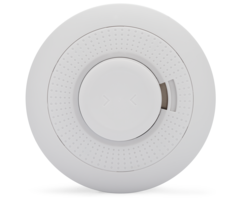Wireless Heat Detectors




Wireless heat detectors are used for detecting fires in locations where smoke detectors may cause false alarms on the system. The way that a heat detector works is by looking for the extremely high temperatures that would only be present with a fire. You should not confuse a heat detector with a temperature sensor. The typical temperature sensor will respond to high temperatures that might occur when the AC is broken so that the user can know to fix the HVAC system in the building. But a heat detector will only activate when there is a much higher temperature that wouldn't be caused by a broken HVAC system alone. The typical heat detector will activate at around 135 degrees Fahrenheit, but this will vary between different sensor models.
If you are trying to choose between smoke detectors and heat detectors, please be aware that we recommend using smoke detectors in most situations. This is because smoke detectors will respond to fires more quickly than heat detectors. But the advantage to using heat detectors in certain locations is that they are often less prone to false alarms. Fine particles can sometimes get into smoke detectors and cause them to activate when they shouldn't. This is a concern in very dusty areas such as attics and garages. High humidity is also a concern, so you won't want to use smoke detectors in bathrooms. Finally, you might not want to use a smoke detector in the kitchen, as cooking food could result in accidental activation of the smoke detector. All of these locations are great candidates for heat detectors.
Remember that there are also combination sensors that offer both smoke detection and heat detection functionality. These devices are always great, as having multiple methods for detecting a fire is almost always preferred. But if you are using the device in any of the aforementioned areas, then it might be best to just get a standalone heat sensor. There are many wireless heat detectors available, and you can certainly find one that suits your needs. Keep in mind that heat rises, so you will want to have the device mounted high up on the wall or on the ceiling. You will program the device as a Fire Zone so that the system knows to go into fire alarm once the device is activated.
All of the heat sensors listed on this page are wireless devices. This makes them easy to install for DIY users, as you do not need to run wires from the panel to the sensor. However, you must make sure that the wireless sensor communicates at a frequency that is compatible with your security system. But as wireless devices, you often do not need any tools to mount the sensor. You can usually mount using double-sided foam tape to prevent the need for drilling holes into the wall or ceiling. You may need a screwdriver to open up the sensor, but that should be it. Then assign the device to one of the wireless zones on your system. Make sure to test the sensor after installation. Many heat sensors have a test button, or you can use a hair dryer on maximum power to test.






